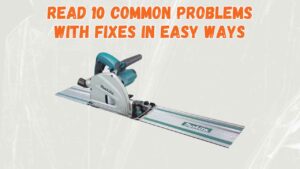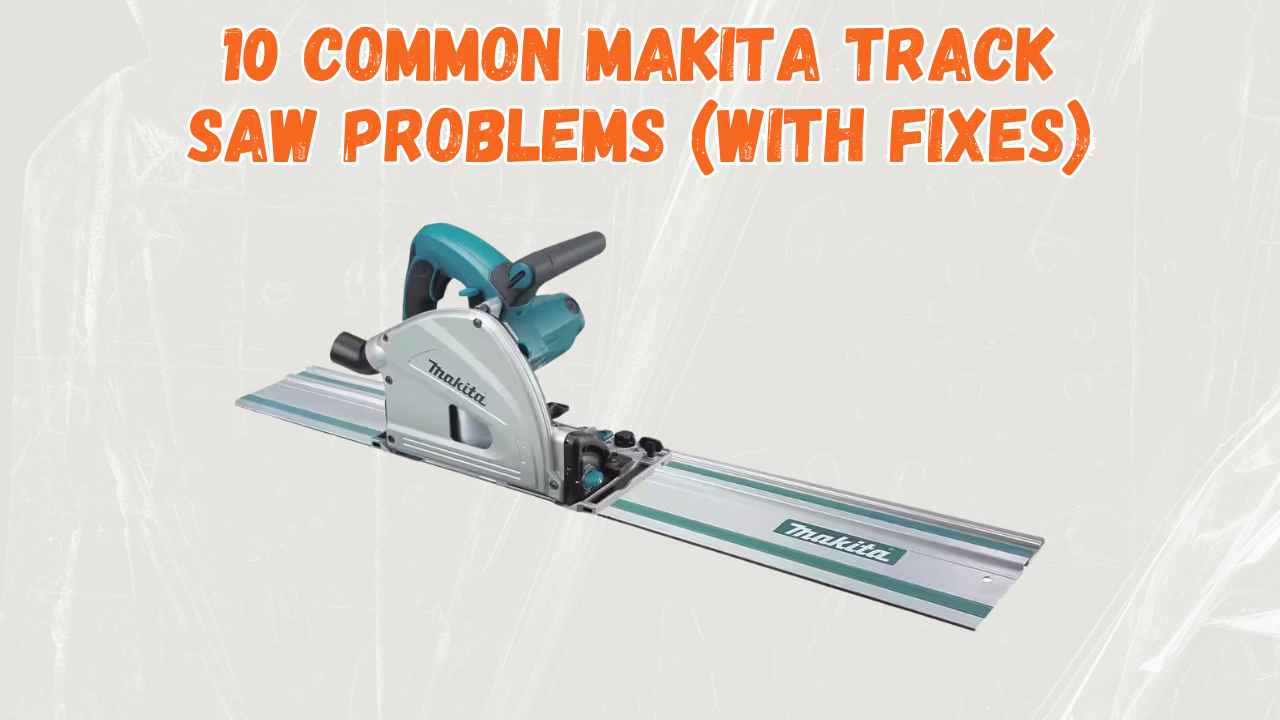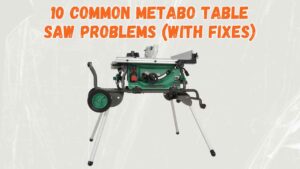Struggling with your Makita track saw? You’re not alone! From uneven cuts to motor issues, these tools can face a variety of challenges over time.
In this guide, we’ll break down 10 common Makita track saw problems and explain simple fixes to get your saw back in top shape.
Let’s tackle these issues together!
Makita Track Saw Problems (Short Overview)
Makita track saws are great tools, but they can run into problems like uneven cuts, blade misalignment, or power loss.
These issues often happen due to wear and tear or improper setup.
Don’t worry most of these problems have quick fixes that you can handle yourself to get your saw working perfectly again!
Read 10 Common Problems With Fixes In Easy Ways…

1. Blade Misalignment
Blade misalignment in your Makita track saw can cause uneven cuts or difficulty following the track.
Causes
- Incorrect blade installation or adjustment.
- Damage or debris on the guide rail affecting alignment.
Fixes
- Check and adjust the blade alignment according to the user manual.
- Clean the guide rail and inspect for any damage.
- Tighten any loose components to ensure proper positioning.
2. Power Loss
One common problem with Makita track saws is unexpected power loss, which can disrupt your work and slow you down.
Causes
- Damaged or loose power cord connections
- Worn-out or dirty motor brushes
- Overloading the circuit due to high power usage
Fixes
- Inspect and replace the power cord if it’s damaged.
- Clean or replace the motor brushes to ensure proper contact.
- Avoid overloading circuits and consider using a dedicated power source for the saw.
3. Uneven Cuts
One common issue with Makita track saws is uneven cuts, which can ruin the precision of your projects.
Causes
- Misaligned track or saw
- Worn or dull blades
- Dust or debris interfering with the track
Fixes
- Ensure the track and saw are properly aligned before cutting.
- Replace dull or worn-out blades regularly.
- Clean the track and saw frequently to remove dust and debris.
4. Track Slippage
Track slippage is a common issue with Makita track saws, where the saw doesn’t glide smoothly along the guide rail, leading to uneven or inaccurate cuts.
This can disrupt precision and make your projects frustrating.
Causes
Track slippage often happens due to dust or debris buildup on the guide rail, worn-out rubber strips, or improper alignment of the track and saw.
Fixes
To fix this, clean the guide rail regularly to remove debris and inspect the rubber strips for wear. Replace them if needed.
Ensure the saw is properly aligned with the track, and adjust the tension settings for a secure fit.
Read Also:
Metabo table saw problems
5. Motor Overheating
One common issue with Makita track saws is motor overheating.
This typically happens when the saw is overworked, used for extended periods without breaks, or when dust clogs the ventilation system.
Overheating can lead to reduced performance or even permanent motor damage if not addressed promptly.
Causes
- Prolonged use without letting the motor cool down
- Blocked vents due to sawdust buildup
- Using the saw with a dull blade, putting extra strain on the motor
Fixes
- Give the saw regular breaks during heavy use
- Clean the vents frequently to ensure proper airflow
- Replace or sharpen the blade to reduce strain on the motor.
6. Dust Buildup
Dust buildup is a common issue with the Makita track saw, causing reduced performance and cutting precision.
Over time, sawdust can clog the internal components or block the dust port, making the tool harder to use and potentially overheating the motor.
Cause
The primary cause of dust buildup is insufficient dust extraction or using the saw without connecting a proper vacuum system.
This allows sawdust to accumulate inside the tool and around the blade.
Fixes
To fix this, regularly clean the saw after use, focusing on the dust port and internal areas. Use a vacuum or compressed air to remove debris and improve airflow.
Also, ensure you’re working with a high-quality dust extraction system to prevent future clogging.
7. Worn Blades
Using a worn-out blade is a common issue with Makita track saws that can lead to poor cutting performance and uneven results.
Dull blades put extra strain on the motor and may cause overheating, leading to long-term damage if not addressed in time.
Cause
Blades wear out over time due to frequent usage, cutting dense materials, or improper handling. This reduces their sharpness and efficiency, making cuts less precise.
Fixes
Regularly inspect your blade for wear and tear. Replace it with a compatible, high-quality blade when you notice dullness or performance issues.
Proper maintenance, like cleaning the blades and avoiding overuse, will help extend blade life and keep your saw running smoothly.
8. Battery Draining
One common issue with Makita track saws is rapid battery drainage, which can disrupt your workflow.
Causes
- Overuse or extended cutting sessions
- Old or damaged battery cells
- Incorrect charging practices or faulty charger
Fixes
- Take breaks to prevent overheating and overuse
- Replace old batteries with genuine Makita replacements
- Use a compatible charger and follow proper charging guidelines guidelines
9. Loose Fasteners
Loose fasteners can cause serious issues with your Makita track saw, impacting its precision and performance.
Over time, vibrations from regular use may loosen bolts or screws, leading to instability during operation.
Cause:
Frequent use and vibrations can gradually loosen the fasteners, especially if they weren’t secured tightly during assembly.
Fix:
Regularly inspect your track saw for any loose bolts or screws. Tighten them using the appropriate tools to ensure everything is secure.
Adding a thread locker can also help prevent them from loosening again. Routine maintenance is key to keeping your saw running smoothly.
10. Poor Calibration
One common issue with Makita track saws is poor calibration, which can lead to inaccurate cuts and frustration during use.
Cause:
Poor calibration can happen due to improper setup, wear and tear on the components, or even accidental knocks during use or storage.
Fixes:
To resolve this, start by checking the alignment of the track and blade. Ensure the saw is securely mounted and adjust the calibration settings as per the user manual.
Regular maintenance and careful handling can also help prevent this issue from recurring.
FAQs
What is the cutting depth of the Makita Track Saw?
The Makita Track Saw typically offers a cutting depth of up to 2-3/16 inches at 90 degrees and 1-9/16 inches at 45 degrees, depending on the model.
Does the Makita Track Saw work without the track?
Yes, the Makita Track Saw can be used without the track, but it is designed to deliver optimal performance and precision when paired with the guide rail.
What type of blades are compatible with the Makita Track Saw?
The Makita Track Saw is compatible with 6-1/2 inch circular saw blades, suitable for wood, laminate, and other materials, depending on the blade type.
Is the Makita Track Saw suitable for plunge cuts?
Yes, the Makita Track Saw is designed for precise plunge cuts, offering excellent control and accuracy in various applications.
How do I maintain the Makita Track Saw for long-term use?
Regularly clean the saw, check its calibration, and ensure the blade and track are free of debris. Lubrication and proper storage also help maintain its performance.






[…] 10 Common Makita Track Saw Problems (With Fixes) […]